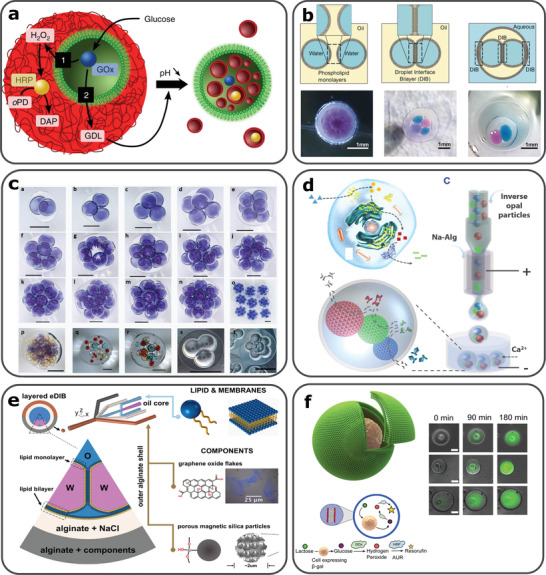Figure 6.

a) Guest‐host protocell construct for activation of synergistic or antagonistic behaviors. Glucose oxidase (GOx) containing proteinosome (guest protocell), trapped in a fatty acid micelle coacervate (host protocell). Depending on the glucose concentration of the surroundings, pathway 1 (synergistic) or 2 (antagonistic) is initiated. Low glucose concentration causes the coacervate to become fluorescent and high glucose concentration decreases pH and induces the formation of fatty acid vesicles. Reproduced with permission.[ 211 ] Copyright 2018, Springer Nature. b) Schematic illustration for the formation of DIBs, multicore artificial cell constructs produced by droplet microfluidics and one or multiple DIBs and aqueous solutions encapsulated in a hydrogel capsule. Reproduced with permission.[ 213 ] Copyright 2016, John Wiley and Sons. c) Highly compartmentalized capsules produced using novel bat‐wing junction, a–o) 2–15 water droplets encapsulated within solid semi‐permeable capsules, p–r) Different water droplets trapped in solid TMPTA solid capsules, s,t) encapsulated DIB networks in TMPTA/water/squalene. Reproduced with permission.[ 240 ] Copyright 2017, Royal Society of Chemistry. d) Enzymatic reaction pathway in a natural eukaryotic cell and cell inspired hollow hydrogels encapsulating inverse opal particles with immobilized enzymes fabricated using microfluidics. Reproduced with permission.[ 218 ] Copyright 2018, AAAS. e) Encapsulation of DIBs in alginate shells using non‐planar droplet microfluidic device. The outermost shell contains components such as magnetic particles, which offer mobility to the artificial cell construct in the presence of a magnet. Reproduced with permission.[ 127 ]. Copyright 2019, John Wiley and Sons. f) Vesicle‐cell engineered hybrid, where hydrolysis of lactose to glucose within the hybrid causes a chemical reaction that produces fluorescence. Reproduced with permission.[ 230 ] Copyright 2018, Springer Nature.
